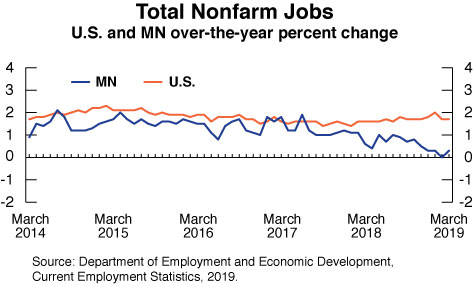by Nick Dobbins
April 2019
Employment in the Minneapolis-St. Paul-Bloomington MSA was up by 2,489 jobs (0.1 percent) in March. Goods producers added 2,612 jobs (1 percent), while service providers lost 123 (0 percent). Mining, Logging, and Construction was up by 3,013 (4.3 percent), and Leisure and Hospitality was up by 2,130 (1.2 percent). Government employers lost 2,442 jobs (1 percent) with losses at all three levels of government. Professional and Business Services also lost jobs, off by 1,072 or 0.3 percent, thanks to the loss of 1,310 jobs (1.3 percent) in Administrative and Support and Waste Management and Remediation Services. Over the year the metro area’s employment was mostly flat, off by 76 jobs (0.0 percent). Gains in goods production (up 2,616 or 1 percent) were offset by losses in service provision (off 2,692, 0.2 percent). Financial Activities added 1,557 jobs (1.1 percent), Mining, Logging, and Construction added 1,437 (2 percent), and Manufacturing added 1,179 (0.6). Educational and Health Services lost 4,603 jobs (1.4 percent), while Professional and Business Services lost 1,261 (0.4 percent).
The Duluth-Superior MSA added 110 jobs (0.1 percent) in March, with all of those gains coming from the private sector (up 123 or 0.1 percent). Trade, Transportation, and Utilities added 163 jobs (0.7 percent). Educational and Health Services was among the most prominent job-losers, off by 140 jobs (0.4 percent). Other Services added 91 jobs (1.4 percent). Over the year the Duluth area lost 614 jobs (0.5 percent), with declines in almost all major published series. The biggest exception was Mining, Logging, and Construction, which added 228 jobs or 2.7 percent and was significant enough to push all goods producers into positive job growth for the year. Educational and Health Services lost 204 jobs (0.6 percent), Leisure and Hospitality lost 261 (1.9 percent), and Trade, Transportation, and Utilities lost 233 (1 percent).
The Rochester MSA added 827 jobs (0.7 percent) in March. Educational and Health Services employers added 440 jobs (0.9 percent), Leisure and Hospitality added 136 (1.2 percent), and Government employers added 187 (1.4 percent) mostly at the local government level. The biggest decline, in both a real and proportional sense, came in Trade, Transportation, and Utilities, which lost 59 jobs or 0.3 percent entirely from a decline of 81 (0.7 percent) in the Retail Trade component sector. Annually the Rochester area added 1,551 jobs (1.3 percent). Educational and Health Services added 636 (1.3 percent), Leisure and Hospitality added 275 (2.6 percent), and Manufacturing added 472 (4.6 percent). The largest over-the-year job loss in the area came from the smallest supersector, as Information shed 145 jobs or 8.3 percent. Trade, Transportation, and Utilities lost 111 jobs (0.6 percent), and Financial Activities lost 68 (2.4 percent).
The St. Cloud MSA added 150 jobs (0.1 percent) in March. Mining, Logging, and Construction added 239 jobs (3.8 percent), and Manufacturing added 121 (0.8 percent). Service providers lost 210 jobs (0.2 percent) with all but Other Services, which added 3 jobs or 0.1 percent, losing jobs. Leisure and Hospitality lost 52 jobs (0.6 percent), and Educational and Health Services lost 86 (0.4 percent). Annually the St. Cloud MSA added 1,709 jobs (1.6 percent). Mining, Logging, and Construction led the way, adding 1,030 jobs or 18.8 percent. Educational and Health Services chipped in 770 jobs or 3.5 percent. Trade, Transportation, and Utilities lost 374 jobs (1.7 percent) on the loss of 478 jobs (3.6 percent) from the Retail Trade component. Information employers lost 110 jobs or 7.9 percent.
The Mankato-North Mankato MSA added 170 jobs (0.3 percent) with growth in every published employment series. Private sector employers added 136 jobs (0.3 percent) while public sectors employers added 34 (0.3 percent). Goods producers added 111 jobs (1.1 percent), and service providers added 59 (0.1 percent). On the year the Mankato-North Mankato MSA added 138 jobs (0.2 percent). Goods producers drove the growth, adding 166 jobs (1.7 percent), while service providers lost 28 (0.1 percent). The private sector lost 43 jobs (0.1 percent), and government employers added 181 (1.8 percent).
The Fargo-Moorhead MSA lost 144 jobs (0.1 percent) in March. It was the only reported MSA in Minnesota with over-the-month job losses. Unlike elsewhere in the state where the supersector had 3.1 percent growth, Mining, Logging, and Construction in Fargo lost 86 jobs (1.2 percent). The largest proportional decline came from government employment, which was off by 1.4 percent (290 jobs). Annually the Fargo-Moorhead MSA lost 498 jobs (0.4 percent). Trade, Transportation, and Utilities lost 742 jobs (2.5 percent) with a decline of 941 (6 percent) in Retail Trade. Leisure and Hospitality lost 663 jobs (4.7 percent).
The Grand Forks-East Grand Forks MSA added 113 jobs (0.2 percent) in March. Leisure and Hospitality led the growth, adding 160 jobs (2.7 percent). No other supersector in the MSA added or lost more than 60 jobs. Annually the Grand Forks-East Grand Forks MSA lost 741 jobs (1.3 percent). Trade, Transportation, and Utilities drove the decline, shedding 404 jobs (3.6 percent) with the loss of 490 jobs (6.7 percent) in Retail Trade. Government employers shed 508 jobs (3.5 percent), the bulk of those losses (483 jobs) coming from state-level employers. Notable annual increases occurred in Professional and Business Services (up 219 or 6.8 percent) and Financial Activities (up 112 or 5.8 percent).
Monthly analysis is based on unadjusted employment data.
